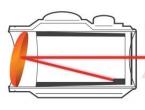What is mold for foamiran. What molds are best to choose for creating leaves from foamiran? Tools for working with foamiran
Molds and weiners for flowers (and in a different way, forms) come in a wide variety of types and sizes. The most popular forms to give realism to leaves and flower petals. Moldno is called the hard part, and the flexible silicone part is called the weiner. It is very easy to use them.
Often one mold can be used in the manufacture of different colors. For example, a mold of a universal petal - for decorating small and large leaves of various shapes with a common mesh pattern. Lily leaf mold - for any flowers with longitudinal straight veins: lilies, lilies of the valley, tulips, geocinths, etc.
How to use mold and weiner with foamiran?
1. Cut out the petal or leaf blank
2, We apply for a few seconds to a hot iron (if there is no iron, you can use something else, even a curling iron :))
3. Quickly put a warm sheet on the mold, level it, cover it with the mold and strongly squeeze the mold and the weiner together. The pattern prints better on warm foam.
Important! Place the workpiece evenly on the mold so that the veins do not go obliquely. Act very quickly, as the foam cools quickly.
You can only use mold. Then put the hot petal on the mold and carefully press it on top with your hands to get an imprint.
Some molds have deep veins, so that the texture is clearly visible on the leaves. Other molds make not only the texture, but also give the petal the necessary bend. In some molds, the veins are almost invisible (for example, Alstroemeria mold and Weiner), but they are important precisely because they bend the petal in the right way.
How to properly use the plastic weiner to use
Molds and veiners are tools that are used in floristry to create flowers (leaves and petals) from foamiran, polymer clay, cold porcelain, which allow them to be as realistic as possible.
Double mold - designed to give shape and texture to foamiran and other materials on both sides. After processing foamiran (plastic suede), it conveys in detail the relief and all the veins of the sheet to the material.
I want to bring to your attention a master class on how to properly use a double mold when working with a fom. Let's make a leaf using a plastic weiner.
Read also:
If after the interview you were not invited to work, then you want to get at least honest feedback - why, what is wrong? It is useful to learn about your weaknesses in order to avoid mistakes with another vacancy. But often, applicants receive a formal letter without specific reasons for refusal, or in response, there is silence at all. We found out why this happens and how to get useful information from a recruiter...
The Savanna Pro School encourages you to take a perucaring course near Vinnytsia and create your own mind - to become a professional in the gallery of creating creative haircuts. Finding such a specialization is not so easy, but maistri obov "clearly help you reach the planned level in Perukarsk law. Starting from scratch For beginners, the school of beauty will propagate the program of starting from zero level. Beginners can op...
Personnel management is the purposeful activity of the company's management in personnel management. Personnel management is the purposeful activity of the company's management in personnel management. The additional list of the main tasks of the relevant expert also includes: development of the concept and strategy of personnel policy; selection of methods and principles for the management of...
Football is the game of millions. In every modern country there is a whole army of fans of this sport. Fans are familiar with the names of the players and follow the games during the season. The love of football is tied to early childhood, so it's no surprise that many kids dream of becoming top players. Moreover, a successful career in football is not only about prestige, interesting travels, and recognition...
A few years ago, domestic needlewomen had another opportunity to realize their creative plans. The fact is that a material called craft foam (craft foam), or, as it is called in the CIS, foamiran or foam, has become widely available. What is this substance, what types of it are found and how to work with foamiran? Let's look at all these questions in more detail.
What is foamiran
This word refers to a decorative foam material for needlework, made from a polymer of ethylene vinyl acetate. Because of the rough surface, this material is also called plastic suede, revelure and other terms.
It received its special name - "foamiran" - in Polish, Ukrainian, Russian and other Slavic languages because of the manufacturing country - Iran (foam Iran), which is the largest supplier of this material in the world.
In addition to Iranian, you can encounter Chinese, Korean and Turkish foamiran.
Depending on the country of manufacture, the color range of the material is also different, as well as its density, uniformity of color and length.
Foam Features
Before you figure out how to work with foamiran, you should find out what are the features of this material for creativity.
The main advantage of the foam is its lightness (one might even say: airiness), as well as the ability to change shape when heated, and when cooled, it retains it.

This property is used by domestic needlewomen to make beautiful and incredibly realistic flowers and hair ornaments, brooches. After all, unlike plastic, foam is very light, pliable and soft. Also, with its properties, it surpasses fabric and leather - it firmly holds a given shape, is not afraid of moisture and does not fade, and its cost is very low. In addition, this material is easily dyed and embossed.

It is worth noting that in the USA and China, other areas of application of foam are more common - costumes for cosplay and carnivals are made from it.
In addition, in the industry, puzzles, designers and children's kits for creativity are made from this material.

Types of foamiran
Foam is different. In the CIS, it is most often found in the form of thin sheets of A-4 format or rolls. As a rule, the thickness of the material in this form is 1-1.5 mm. Sheet and roll foamiran is perfect for creating jewelry and flowers.

Less popular among domestic needlewomen are sets of various foam figures, numbers or letters.
In other countries, in addition to thin material, thick sheet craft foam (from 1 cm) is very common, on which patterns can be carved, like on a tree. Thanks to this property, foamiran is the most common material for creating costumes for cosplaying fantasy and anime characters.

As for the appearance of thin foam, there are several varieties of it.

Tools for working with foamiran
Before you learn how to work with foamiran, it is worth considering which tools should be used for this.

- First of all, these are scissors, because it is with their help that it will be possible to cut out the details of the future product. In addition to the usual tailor's and small sewing, curly scissors can be used when working with foam. However, it is worth remembering that they must be of good quality and sharp - otherwise they can chew the material, and not cut.
- To heat foamiran (to give it plasticity), an ordinary iron, curling irons and hair straighteners or a lighter are most often used.
- To give the details the desired shape, special tools are often used - stacks. They have sharp, round and curly tips. Beginning craftswomen use toothpicks or needles instead of stacks.
- For painting foamin, there are specialized dyes. However, in domestic spaces, the most popular dye remains oil pastel or children's
- For fastening foam parts, either Moment glue or a glue gun will be the most optimal. PVA, "Dragon" and other handmade adhesives are ineffective in this case, since they harden for a long time.
- And the last very important tool for working with craft foam is molds (moulds to give the material volume and the desired texture). A beginner needlewoman does not need them. But for those who are seriously interested in foamiran, they cannot be dispensed with.
- To cut out details from craft foam, you can also use figured punchers, plotters, machines for cutting and embossing.
with foamiran
Before starting work, you should prepare all the tools, as well as the workplace, which should not have anything superfluous. As an example of how to work with foamiran, let's take an example of making a small rose.


How to work with foamiran molds
The above example is suitable for those who are just mastering foamiran. Over time, it is worth starting to improve your skills - to master molds. They can be purchased at the store, ordered online or made by hand.

In your arsenal, you must have at least two molds: one for leaves, the other for making petals.
You need to use molds after dyeing the foamiran, heating the material on the iron and pressing it against the tool. You need to press the part against the mold until it cools and hardens, usually it takes a few seconds. After this, the edges can be trimmed, although some craftsmen do this before working with the mold.
It is always important to make the part to be deformed larger than necessary, as it will shrink when heated.
Molds are single (emboss on one side) and double (shape on both sides). When working with single ones, it is important to put another piece of foamiran on top of the part, which will prevent fingerprints from appearing on the finished product. In double molds, this is not necessary.
How to work with non-standard types of foam
In recent years, 2 new types of craft foam have appeared on the domestic market. One of them is marshmallow foamiran. How to work with him? Let's figure it out.

Before work, this material should be specially processed. To do this, the cut out part is tinted with pastel and (putting it between two sheets of paper) is ironed in steam mode.
When the part has cooled down, it is removed (after processing, the material becomes very thin, almost transparent) and applied to a hot iron. Further - process mold.
After this procedure, the processed part is kneaded and slightly stretched in the hands. If necessary, the edges are slightly warmed up with a lighter.
Having considered the method of processing marshmallow foam, let's find out how to deal with its counterpart called silk foamiran.
How to work with him? Much easier than marshmallow because it is less capricious. There is no need to iron it beforehand, because it is already thin and plastic and does not bubble on the iron, like marshmallow.
When working with silk foam, the cut out part must be heated on an iron and deformed with a mold. Further form is given by hand. If necessary, use a lighter.
Having considered the features of foamiran, as well as its types, we can conclude that this material is an indispensable thing in the arsenal of every needlewoman. And if we take into account that domestic craftswomen do not fully use the opportunities that this material has, we can conclude that it has a great future in the vastness of our country.
Today we have prepared for you a short excursion into the varieties of molds, with which you can create various leaves from foamiran.
We often have to face questions about which ones are best for foamiran. And so in this article we will share the opinion of our experts and tell you which molds they use most often when creating leaves.
Of course, it is best to have a wide variety of molds in your arsenal, as situations often arise when the size of the mold does not quite fit or you would like to get a slightly different effect. But most often, as a rule, the most versatile molds are used. So let's go.
This mold is the most favorite mold of our masters! It gives such thin, but at the same time clear prints that are pronounced even without any toning. And by adding additional shades, you can get a real masterpiece. What can I say, see for yourself.
Characteristics of the mold
Length: 9 cm.
Width: 7 cm.
The rose leaf mold is suitable for making rose, gardenia, rosehip, poinsettia, holly, sakura, apple, sunflower, plumeria, peony leaves, etc.
This mold is a panacea for those who are not indifferent to voluminous leaves. Now you will probably say that there is nothing better than double molds to create such an effect, but we hasten to please you - there is. And here's the proof! At first glance, it is not even clear that this is an ordinary single mold. The veins of the rosehip leaf (wild rose) are so pronounced that you can feel the relief on absolutely every side of the leaf side - both from the front side and from the wrong side.
Characteristics of the mold
Length: 8 cm.
Width: 4 cm.
Compatibility: foamiran. This mold is not suitable for clay.
Another mold that will fit most leaves. The veins from this mold are pronounced, fleshy, not thin. In addition, the size of the mold allows you to create the most versatile leaves.
Characteristics of the mold
Length: 7 cm.
Width: 6 cm.
Compatibility: foamiran and clay.
This mold is suitable for most leaves with longitudinal venation. Clear, pronounced veins create a slight effect of volume, and as a final treatment it is best to use beautiful tinting with various dyes.
Characteristics of the mold
Length: 14 cm.
Width: 5 cm.
Compatibility: foamiran and clay.
Yes, maybe not every one of you makes grape leaves, but this mold is great for currant leaves, as well as maple leaves, which are very often used when creating autumn-themed products. Mold is convenient because it contains 3-5 directions of veins at once. It can be used in such a way that only one part is involved. The veins of the grape leaf mold, as well as the rose leaf mold, are very small and this creates a complete feeling of realism, detail.
If you do not have a grape leaf mold, you can use it by applying it alternately to all parts of the leaf.
Characteristics of the mold
Length: 9 cm.
Width: 7 cm.
Compatibility: foamiran and clay.
Having the most necessary molds always at hand, you can create a variety of flowers. Our market is so large that you will definitely pick up everything you need for yourself.
We hope that the information given in this article will help you form your own set of tools necessary for working with foamiran. All molds in our market have an additional manufacturer's quality guarantee! Be sure of the quality and use only good molds, because the level of your work and the convenience of using these indispensable helpers depend on it. And always remember that you can make a truly beautiful leaf not only using mold, but also.
Molds, which were originally used for ceramic floristry, conquered foamiran masters, greatly expanding their capabilities. So, thanks to these simple, embossed forms, you can quickly and easily get a clear, natural relief of flower petals and flowers. What are molds and make these useful forms with your own hands - read below.
So, mold is a cast, flat mold for making relief elements on the front surface of a foamiran blank. Weiner is a voluminous silicone mold, which makes it possible to obtain not only convex veins, but also to make the edges of foamiran blanks curly. Such forms are great for creating floral elements of plants with curly petals and leaves (rose, dahlia, lily, etc.).

There are a huge number of Moldovans and viners, and sometimes it is incredibly difficult to choose the right one from such a variety. What molds are better? Experienced craftsmen say that the best forms that give clear impressions and do not tear the fom are Thai. But the price of such products is quite high.
If there is no opportunity to purchase a ready-made mold, then, for the first time, you can replace it with improvised means (for example, plates with a floral texture, a cutting board, ceiling tiles). Some craftsmen adapted themselves to work with needles and toothpicks, applying relief by hand. But, it’s better to make an element with your own hands: the cost of such a mold will be much lower than the cost of purchased ones, and the result is much better than from improvised means.
Mold for flowers from foamiran
The simplest, most versatile way to make molds with your own hands is with the help of viscous and plastic polymer clay. For work, we need: fresh polymer clay of any color, a live leaf with well-protruding veins (it is better to choose blackberry, raspberry, begonia leaves), a clerical knife or a thin blade, ceramic tiles or unnecessary faience utensils, a metal baking sheet for baking clay, a needle.

Making molds:
- Roll out the clay in a fairly thick layer.
- We apply a sheet to the clay and press it tightly with our fingers, in order for the veins to be better imprinted, we pass over the sheet with a rolling pin from above.
- We hook the leaf with a needle and carefully remove it from the workpiece.
- We cut off excess clay with a clerical knife or blade, giving the workpiece the shape of a leaf.
- We send the negative mold to the oven and bake according to the instructions for the polymer clay used in the work.
- Roll out another layer of clay.
- Wet the cooled negative with water (from the side of the veins) and lay it on the rolled out layer.
- We press it with our fingers and roll it out with a rolling pin.
- We separate the negative and cut off the excess from the workpiece.
- We send the relief form to the oven for baking.
After the double forms have cooled down, you can safely use them in your work. In this way, you can make leaves of various shapes and sizes.
If the clay is not viscous enough, you can knead it with your hands using petroleum jelly or a greasy cosmetic cream.
How to make molds for foamiran with your own hands from silicone sealant
Another way to create molds for making flowers from foamiran is with the help of silicone sealant, which allows you to transfer the relief from any voluminous leaf. Making a silicone mold is quite simple: for this we need a sealant, a small spatula, a transparent sheet from a stationery folder, an impression sheet, scissors, a sheet of A4 paper.
Let's get to work:
- We attach a sheet of paper for taking an impression to an A4 sheet and circle it.
- We remove the leaf and put a transparent sheet on the pattern.
- Squeeze out the silicone into a container and use a spatula to transfer it to a transparent sheet so that its size corresponds to the size of the sheet for taking the impression.
- Lubricate the leaf with oil and apply to silicone.
- We leave the silicone to dry for several days (from two to four, depending on the sealant).
- After drying, with a needle, remove the leaf from the silicone.
- With scissors, we give the silicone molds the shape of a leaf.
The work is ready: as a result, we have convenient, high-quality, double-sided forms for quickly creating attractive, natural foamiran leaves.
With what else can you make molds for foamiran
You can quickly and easily make molds from corn or potato starch and ordinary silicone sealant (available at every hardware store). In order to directly start creating stencils, we need to prepare a mixture for taking impressions: in an unnecessary container, we knead the materials in a one-to-one ratio, first with a wooden stick, and then knead the mass by hand until completely homogeneous (we put on disposable gloves to protect our hands).

Let's get to work:
- Separate a small part from the total mass, form two balls of different sizes from it (one is larger than the second).
- Roll out one ball with a rolling pin so that you get a flat surface 5 mm thick.
- Top with a dried leaf of the desired plant or a handicraft store-bought artificial copy with a good texture.
- Roll out the second ball on top of the sheet.
- Set the workpiece aside: let the mass grab well.
- After some time, separate the top layer from the workpiece and remove the sheet.
- Leave molds to dry. If necessary, you can adjust the edges of the molds to the size and shape of the sheets with scissors.
Even a novice master can easily repeat this master class, and the resulting molds will not only come out inexpensive, but will also give high-quality prints due to their elasticity and flexibility. You can use these forms more than once.
We make molds for foamiran with our own hands: a master class (video)
Molds and viners are incredibly useful stencils for working with foamiran, allowing you to easily and quickly transfer the relief to the workpiece. Such forms can be purchased in stores, or you can make it yourself, saving, at the same time, a little money. Make molds and viners with your own hands, and get original, attractive, expressive textures to create high quality works!





